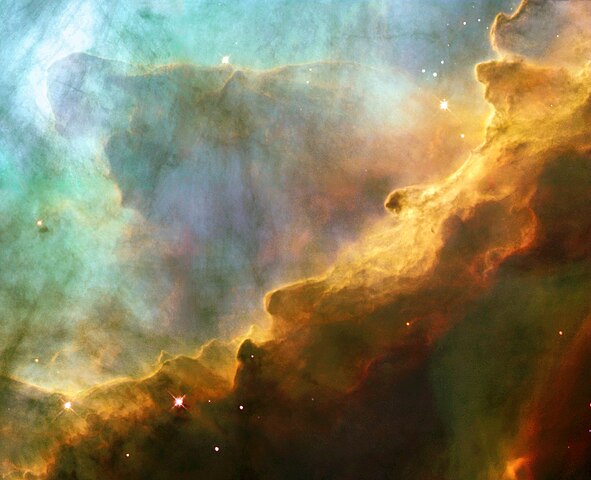
What is a nebula? It is an enormous cloud of dust and gas in space.
The word nebula is a Latin word, and it means “mist or cloud”. You can see it in the root of the word nebulous. And when we say enormous, most nebula are tens to hundreds of light years across. They form in the interstellar medium, which is the open space between stars. They are made of hydrogen, helium, and cosmic dust. Before the nature of nebulae were understood, galaxies were also called nebula. Today, there is a clear distinction between galaxies and nebula.
In the majority of empty space, there is only one atom per cubic centimeter. However, in some places, gas and dust molecules might collect together. As the quantity increases, the gravity increases and they start to attract more gas and dust. This is the birth of a nebula and once the gas and dust have started to accumulate, it begins to grow. Nebulae are still not very dense, though. The densest nebula has a density of 10,000 molecules per cubic centimeter. On Earth, a cubic centimeter of air has 10,000,000,000,000,000,000 molecules, so you can see how thin a nebula is. If you had a nebula cloud that was the size of Earth, it would only weigh about a kilogram.
Nebulae are called “star nurseries” because all stars in the universe have formed from them. The growing nebula attracts more gas and dust, and the increasing gravity starts to pull the gas and dust together into small lumps. These lumps attract more lumps, and it continues until there is so much mass that the nebula collapses in on itself. The incredible gravity and pressure at the center of the collapsing nebula starts nuclear fusion and a sun is born. The leftover dust and gas in the nebula will go on to form planets.
Not all nebula form when dust and gas accumulate. There are three ways that nebula can form. The first way is with the accumulation of matter, as we have just discussed. This kind of nebula can be any shape and they look like a collection of gas and dust.
The second way is when a dying star releases matter. All stars are a balance of pressure and gravity. Gravity tries to crush the star as small as it can possibly go, while the nuclear fusion going on in the sun creates pressure which stops gravity from crushing the sun. When a star like our sun has converted all of its hydrogen fuel into helium, there is less pressure to fight against gravity and the core starts to collapse. At the same time, the outer layers expand. The helium in the core will be converted into heavier elements, becoming smaller and denser. The outer edge of the star will expand to many times its original size and it will start to pulse. Finally, the core will be crushed even smaller and the gravitational pull on the outer layers will have gone. The outer layers will drift off into space, forming a nebula. This type of nebulae are usually circular.
The third way a nebula is formed is from a supernova. A supernova can only happen in a star that is eight times bigger than our sun. Giant stars have the same balance of pressure and gravity. When they run out of fuel, they cool down and there isn’t enough pressure to fight gravity. When this happens, the giant star that is 8 times larger than our sun, collapses in seconds. This collapse produces a shockwave that flings the outer part of the star into space, forming a nebula. Depending on the type of supernova, all of the star can explode, or just the outer shell explodes and the core can remain as a neutron star. These nebula are ring shaped as well.
If they are just gas and dust, and they are not very dense, how can we see them? There are three ways. One type of nebulae are called emission nebulae because they emit their own light. When there is a hot star near to the nebula, it sends out high energy ultraviolet light that ionizes the hydrogen gas. When hydrogen gas is ionized, it emits light and glows. The second way is because they reflect the light of the stars around them. These nebulae do not emit their own light, but shine brightly thanks to the light of stars, in the same way as our moon. And the third way is because they block out the light from stars behind them. Some nebulae are called dark nebulae because they don’t emit light or reflect it. They are made of a lot more dust that absorbs light. In this way they can be seen because of what they block out. There are several of these in the Milky Way that can be seen with the naked eye. And this is what I learned today.
Image By NASA, ESA and J. Hester (ASU) – http://spacetelescope.org/images/heic0305a/ ([cdn.spacetelescope.org/archives/images/screen/heic0305a.jpg direct link])http://hubblesite.org/newscenter/archive/releases/2003/13/image/a/, Public Domain, https://commons.wikimedia.org/w/index.php?curid=688942
Sources
https://spaceplace.nasa.gov/nebula/en/
https://www.space.com/nebula-definition-types
https://hubblesite.org/science/stars-and-nebulas
https://socratic.org/questions/why-are-nebulae-important
https://spaceplace.nasa.gov/supernova/en/
https://en.wikipedia.org/wiki/Nebula
https://www.space.com/solar-system-fate-when-sun-dies
https://www.space.com/23756-white-dwarf-stars.html
https://www.atnf.csiro.au/outreach/education/senior/astrophysics/stellarevolution_postmain.html
